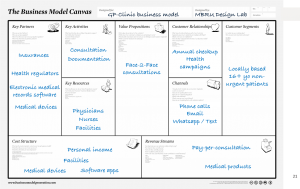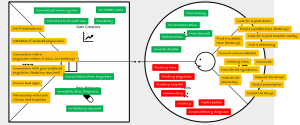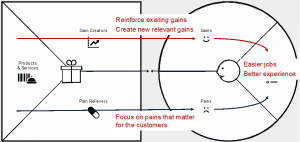Disruption in Healthcare: Tools to Redesign your Business Model
On May 20th, almost 100 physicians, nurses and other medical professionals from around the country/world joined Associate Dean of Innovation and the Future, Professor Homero Rivas and Assistant Professor of Healthcare Innovation and Technologies Dr. Thomas Boillat for their session“Disruption in healthcare: Tools to redesign your business model”. Here’s a synopsis of what was covered during the session:
Many Events Can Disrupt a Business
Whether a hospital or clinic, a medical device company, or a restaurant establishing a business is not a one-time plan. The market is dynamic, and many factors have an impact such as competition, customer needs/demand, policies, regulations, technologies, and those factors challenge businesses every day. Some of these challenges can be expected. For instance, a hospital can foresee the building of a new, high-tech clinic across the street. A medical device company might see its business threatened by a new technology. Or, a more recent example is the complete shut down of cities and countries globally, to avoid the propagation of a life-threatening virus. So how do businesses stay in the game despite all of these challenges? It’s possible to hire an external consulting company, but who knows your business better than you? Below we introduce two tools that will empower you to redesign your business model and value proposition.
The Business Model Canvas
The Business Model Canvas was designed by Professor Yves Pigneur and Dr. Alexander Osterwalder at the University of Lausanne in Switzerland. It was originally created to help startups to:
- Cleary and systematically describe the key elements involved in the delivery of a product or service
- Understand the required stakeholders and their dynamics
- Establish a common language to ease the communication amongst stakeholders
- Reduce the risk of failure by quickly identifying gaps or misalignments
However, the success of the Business Model Canvas has gone beyond expectations of the authors and it has been used by more than 5 million people working at startups as well as Fortune 500 companies. The Business Model Canvas can therefore be used for any type of business.
Usage of the Business Model Canvas – The example of a small family medicine clinic in Dubai
We will now go through the nine building blocks of the Canvas. It is usually recommended to start with the value proposition – stating the products or services your company offers – In our case, the clinic offers face-to-face consultations. The next block represents the customer segment – which segment of the population does the product or clinic in this case add value. The clinic is open to anyone above the age of 16. Most probably these people live nearby as the clinic is rather small and in walking distance. The next question concerns the channels – through which channels do the customer segment want to be reached? In this case, it will be through phone calls, emails, Whatsapp messages. By not mentioning social media for instance, it shows that the clinic will not use this method to promote its services. The channels are different from the customer relationships. The latter refers to how the customer segment expects the company to establish and maintain a sustainable relationship. The clinic will encourage its patients to come every year for an annual checkup and will design health campaigns (using the channels mentioned above to distribute them). The final block of the Canvas’s right side is dedicated to the revenue streams – what will the customer segment pay for? Patients will mostly pay for the consultations and possibly for additional medical products such as a knee band. In some cases, it won’t be the patient directly who will pay, but we’ll come to that scenario later.
The left part of the Canvas focuses on what the company needs to operate and deliver the value proposition. The key activities and key resources respectively describe what is required to deliver the value proposition. In our case, it includes the consultations as well as all the required documentation (e.g., patient medical records, books, appointments). To perform these activities, the clinic needs physicians, nurses, but also facilities and equipments. The clinic also needs partners to operate. It is important to know on whom you depend. For the clinic, insurances are key as some patients might not afford the cost of care. By partnering with one or more health insurance companies, you’ll be able to cater to additional patients. It is also critical for the clinic to comply with health regulations and in some situations be affiliated with them. The clinic also needs an electronic medical records software and some medical devices. Placing them as key partners and not key resources indicates that there is a long-term relationship with the suppliers. Finally, the cost structure lists all costs linked to operating the company and delivering the value proposition. For the clinic, it includes the personal income, the facilities, the medical devices and the software applications.

The Value Proposition Canvas
The Value Proposition Canvas was designed by the same authors of the Business Model Canvas. They realized that many companies were not only struggling with designing their business model, but also with defining their value proposition. Here is a presentation of the Value Proposition Canvas:
Let’s take a look on how to use the Value Proposition Canvas for our local clinic
When using the Value Proposition Canvas, it is assumed that you already have an idea of what your value proposition will be. You most probably do not have all the parts, but you already have an idea. Otherwise, a “needs finding” exercise will help you get there. In our case, the clinic already knows that’s objective is to help people feel better.
Let’s start with the right section of the Canvas, the customer profile. It is made up of three distinct parts – The customer jobs that represents the tasks that one or more customer segments have to execute to benefit from your product or service. Either interviews or observations will help you understand each step of the journey. The list of jobs is presented in yellow. In green are the gains – What do customers get out of the value proposition. And in red are the pains – What pains or dissatisfies the customers before, during and after consuming the value proposition.
On the left of the scheme is the value map. It represents the product or service that you will offer to the customers. The functionalities or specificities of the product and service are represented in yellow. In green on top are the gain creators – Which way is your product or service a gain creator? What unexpected value do you offer? And finally, in green at the bottom are the pain relievers – How is your product or service making the life of your customer easier.

There is a match between your value proposition and customer needs when the service or product reinforces the gains and relieves the pains.

To learn more about these two canvases, please read the two following books.


